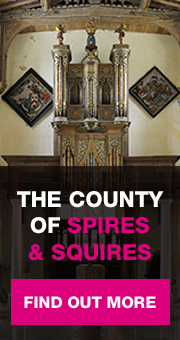14th March 2018
Mike Ingram takes a forensic look at history’s most famous terror plot and how it was very much a Northamptonshire conspiracy…
Everyone knows Bonfire night, but just who and what are we remembering? We all know the name Guy Fawkes, however he was just the man that was given the task of lighting the fuse. The mastermind of the plot (called at the time ‘The Spanish Treason’) was actually Robert Catesby, of Ashby St. Ledger in Northants, a man of “ancient, historic and distinguished lineage” and a direct descendant of Richard III’s leading supporter, executed after Bosworth.
On his mother’s side he was descended from Sir Robert Throckmorton of Coughton, and his second wife, Elizabeth Hussey. His parents were prominent recusant Catholics; his father had suffered years of imprisonment for his faith, and in 1581 had been tried in Star Chamber alongside William Vaux, 3rd Baron Vaux of Harrowden, and his brother-in-law Sir Thomas Tresham, for harbouring the Jesuit priest Edmund Campion. The head of the Throckmortons, Sir Thomas Throckmorton, was also fined for his recusancy, and spent years in prison. Another relation, Sir Francis Throckmorton, had been executed in 1584 for his involvement in a plot to free Mary, Queen of Scots.
The Gunpowder plot was not the first time Catesby had rebelled, as he took part in the Earl of Essex’s rebellion in 1601, where he was wounded and taken prisoner. Queen Elizabeth allowed him to escape with his life after fining him 4,000 marks (equivalent to more than £10 million today).
After the death of Queen Elizabeth, Catholics hoped that the new King James would not only be more tolerant but may even convert to Catholicism. These hopes were quickly dashed when, on 19 February 1604, James denounced the Catholic Church. Three days later, he ordered all Jesuits and all other Catholic priests to leave the country, and reimposed the collection of fines for recusancy. It was this that prompted Catesby to act. He invited Thomas Wintour and John Wright to his house in Lambeth, where they discussed Catesby’s plan to re-establish Catholicism in England by blowing up the House of Lords during the State Opening of Parliament. Wintour then travelled to Flanders to enquire about Spanish support and sought out Guy Fawkes, a committed Catholic who had served as a soldier, engineer and gunpowder expert in the Southern Netherlands. He later recruited Thomas Percy, Robert Keyes, Thomas Bates, Robert Wintour, Christopher Wright, John Grant, Ambrose Rookwood, and Sir Everard Digby.
On 14 October, Catesby invited his cousin and childhood friend, Francis Tresham of Rushton Hall into the conspiracy. Tresham’s father, Thomas, born near the end of Henry VIII’s reign, was regarded by the Catholic community as one of its leaders. He was considered to be clever and well-educated, and was a correspondent of William Cecil, the Secretary of State to Queen Elizabeth, and Sir Christopher Hatton, the Lord Chancellor (also both living in Northamptonshire at Burghley and Holdenby Houses respectively).
He left three notable buildings in Northamptonshire, Rushton Hall, the extraordinary Rushton Triangular Lodge and the unfinished Lyveden New Bield, both of the latter embodying the strength of his faith. The Triangular Lodge bears witness to Tresham’s fidelity to the doctrine of the Trinity. There was also a more personal connection: above the door we find the inscription ‘Tres testimonium dant’ (‘the three bear witness’). It may be a play on his name as ‘Tres’ was his wife’s pet name for him. In Rushton Hall (now a hotel) he built a priest hole – a secret chamber where he could hide Jesuit priests from the government. Thomas was friends with the Jesuit Priest Nicholas Owen, the infamous builder of Priest holes. Owen spent 2 years at Rushton Hall and whilst he was there he constructed a secret escape tunnel for Priests. The tunnel went from the church of St Peter at the front of the Hall, under the house and all the way up to Triangular Lodge. His sense of civic responsibility in local society also led him to begin building Rothwell’s Market House in 1577. Thomas died just weeks before his son launched his treason, however by this time his fortune had been heavily depleted by recusant fines, expensive tastes, and by his son Francis, and Catesby’s involvement in the Essex revolt and whose fines he probably paid.
Francis also had two sisters, Mary who married Thomas Brudenell, 1st Earl of Cardigan from Deene Park and Elizabeth who had married William Parker, 4th Baron Monteagle whose principal residence was at Great Hallingbury, near Bishop Stortford in Essex. Both important Catholic families, although Monteagle had written a letter to his new King with a promise to follow the state religion.
Catesby and Tresham met at the home of Tresham’s brother-in-law and cousin, Lord Stourton. In his confession, Tresham claimed that he had asked Catesby if the plot would damn their souls, to which Catesby had replied it would not, and that the plight of England’s Catholics required that it be done. Catesby also apparently asked for £2,000, and the use of Rushton Hall in Northamptonshire. Tresham declined both offers (although he did give £100 to Thomas Wintour), and told his interrogators that he had moved his family from Rushton to London in advance of the plot.
The details of the plot were finalised in October, in a series of taverns across London in Daventry and the gatehouse of Ashby St. Ledger manor house. A small house was leased in the centre of Westminster where Fawkes lived under the alias “John Johnson” as Thomas Perry’s servant while gathering the gunpowder necessary. By March 1605, 36 barrels of gunpowder were moved to the newly leased out cellar directly under the House of Lords. Fawkes would be left to light the fuse and then escape across the Thames, while simultaneously a revolt in the Midlands would help to ensure the capture of Princess Elizabeth. Fawkes would leave for the continent, to explain events in England to the European Catholic powers.
The Vaux’s were another important Catholic family in Northamptonshire, living at Harrowden Hall near Wellingborough (now a golf club). The third Baron Vaux was convicted of recusancy several times during the reign of Elizabeth I. His second wife was Mary, daughter of John Tresham of Rushton, son of Sir Thomas Tresham I. The third Baron’s son Henry was by May 1585, running England’s priest-smuggling network. Lord Vaux’s eldest two children, Henry and Eleanore, proved to be prodigious learners and in 1568 their father hired Edmund Campion, the future Jesuit martyr but at the time of Oxford University. On 4 November 1586, the chief magistrate of London, Richard Young, led a search of Vaux’s London house before arresting him. He was brought before the Privy Council and committed to the Marshalsea Prison. He contracted pulmonary tuberculosis soon after and was given leave to recuperate in Leicestershire where he was cared for by his sisters, Anne and Eleanore. However, he died suddenly on 19 November 1587.
His daughter Eleanor (later to become the well-known priest-smuggler and recusant, Mrs Brooksby) and her sister Anne (who assisted Eleanore’s recusant work under the pseudonym of ‘Mrs Perkins’) had supported Catholic priests by renting houses where priests could hide. Among these houses was White Webbs in Enfield Chase, which was visited by several of the Gunpowder Plotters. Anne was particularly devoted to Father Henry Garnet, the Jesuit priest who was later executed for his role in the Gunpowder Plot. Another sister, Elizabeth was sent to Caen, in Normandy where she became a nun.
On his grandfather’s death in August 1595, just before his seventh birthday, Edward Vaux became a ward of the queen as a minor heir to the barony. His widowed mother, Elizabeth, known as the ‘Dowager of Harrowden’ remodelled the family estate at Great Harrowden in young Edward’s name, she incorporated hidden rooms for the harbouring of Catholic priests including her confessor, the Jesuit John Gerard.
The wives of those involved became increasingly concerned by what they suspected was about to happen. Several of the conspirators expressed worries about the safety of fellow Catholics who would be present in Parliament on the day of the planned explosion. Percy was concerned for his patron, the Earl of Northumberland, and the young Earl of Arundel’s name was brought up; Catesby suggested that a minor wound might keep him from the chamber on that day. The Lords Vaux, Montague (also from Northants), Monteagle, and Stourton were also mentioned. Keyes suggested warning Lord Mordaunt, his wife’s employer, to derision from Catesby.
On Saturday 26 October, Lord Monteagle (Tresham’s brother-in-law) received an anonymous letter. Monteagle promptly rode to Whitehall and handed it to Cecil (then Earl of Salisbury). Salisbury informed the Earl of Worcester, considered to have recusant sympathies, and the suspected papist Henry Howard, Earl of Northampton, but kept news of the plot from the King, who was busy hunting in Cambridgeshire and not expected back for several days. Monteagle’s servant, Thomas Ward, had family connections with the Wright brothers, and sent a message to Catesby about the betrayal. Catesby, who had been due to go hunting with the King, suspected that Tresham was responsible for the letter, and with Thomas Wintour confronted the recently recruited conspirator. Tresham managed to convince the pair that he had not written the letter, but urged them to abandon the plot.
The letter was shown to the King on Friday 1 November, following his arrival back in London. Upon reading it, James immediately seized upon the word “blow” and felt that it hinted at ‘some strategem of fire and powder’. This led to two searches of the cellars below Parliament. Around midnight on 4/5 November Guy Fawkes was discovered in an undercroft, dressed in a cloak and hat, and wearing boots and spurs. He was arrested, whereupon he gave his name as John Johnson. He was carrying a lantern and a search of his person revealed a pocket watch, several slow matches and touchwood. The 36 barrels of gunpowder were discovered hidden under piles of faggots and coal.
As news of “John Johnson’s” arrest spread among the plotters still in London, most fled northwest, along Watling Street. Christopher Wright and Thomas Percy left together. Rookwood left soon after, and managed to cover 30 miles in two hours on one horse. The conspirators stopped at Ashby St Ledgers at about 6 pm, where they met Robert Wintour and updated him on their situation. They then continued on to Dunchurch, and met with Digby. Catesby convinced him that despite the plot’s failure, an armed struggle was still a real possibility. He announced to Digby’s “hunting party” that the King and Salisbury were dead, before the fugitives moved west to Warwick. They continued on to Holbeche House on the border of Staffordshire, the home of Stephen Littleton, a member of their ever-decreasing band of followers. Tired and desperate, they spread out some of the now-soaked gunpowder in front of the fire, to dry out. Although gunpowder does not explode unless physically contained, a spark from the fire landed on the powder and the resultant flames engulfed Catesby, Rookwood, Grant, and a man named Morgan. The authorities soon caught up with them and 200 men besieged Holbeche House at about 11:00 am on 8 November.
Catesby and Percy were reportedly both dropped by a single lucky shot, while standing near the door. Catesby managed to crawl inside the house, where his body was later found, clutching a picture of the Virgin Mary. Although buried close by, the Earl of Northampton exhumed and decapitated them and their heads were put on display at Northampton.
Guy Fawkes was tortured and finally revealed his true identity on 7 November. He told his interrogators that there were five people involved in the plot to kill the King. He began to reveal their names and how they intended to place Princess Elizabeth on the throne, the next day. His third confession, on 9 November, implicated Francis Tresham. Tresham was arrested on 12 November. He was transferred to the Tower three days later and died on 23 December 1605, probably of urinary tract infection, still protesting his innocence. Despite not being tried, his head joined those of Catesby and Percy on display at Northampton while his body was thrown into a hole at Tower Hill.
On 12 November, Edward Vaux returned to Harrowden Hall to find a three mile cordon around it. The hall was surrounded by one hundred armed men led by William Tate of Delapré Abbey. They were looking for Gerard. For three days they searched the house and interrogated both Edward and his mother. When Tate threatened to start smashing down walls, Elizabeth’s butler told him where the priest hole was. A number of Catholic books were found inside, but no Gerard. Elizabeth was then taken to London for further interrogation but revealed nothing. Soon after, Edward fled to Europe and did not return until 1611.
Agnes, Viscountess Wenman, the eldest surviving daughter of Sir George Fermor of Easton Neston in Northamptonshire, and sister-in-law of Anne Vaux, was also arrested along with her husband Richard Wenman, 1st Viscount Wenman. They were questioned separately in December 1605. Sir Richard testified that he ‘disliked their intercourse, because Mrs. Vaux tried to pervert his wife.’ She was set at liberty after a short confinement in custody. Agnes was buried at Twyford on 4 July 1617.
Having been found guilty of all charges after a short trial, on 30 January 1606, Everard Digby, Robert Wintour, John Grant, and Thomas Bates, were tied to hurdles and dragged through the streets of London to St Paul’s Churchyard. Digby, the first to mount the scaffold, asked the spectators for forgiveness, and refused the attentions of a Protestant clergyman. He was stripped of his clothing, and wearing only a shirt, climbed the ladder to place his head through the noose. He was quickly cut down, and while still fully conscious was castrated, disembowelled, and then quartered, along with the three other prisoners.
The following day, Thomas Wintour, Ambrose Rookwood, Robert Keyes, and Guy Fawkes were hanged, drawn and quartered, opposite the building they had planned to blow up, in the Old Palace Yard at Westminster. Keyes did not wait for the hangman’s command and jumped from the gallows, but he survived the drop and was led to the quartering block. Although weakened by his torture, Fawkes managed to jump from the gallows and break his neck, thus avoiding the agony of the gruesome latter part of his execution.
James’s Council allowed the public to celebrate the king’s survival with bonfires, so long as they were “without any danger or disorder”.
The following January, days before the surviving conspirators were executed, Edward Montagu, 1st Baron Montagu of Boughton House and MP for Northamptonshire suggested that the king’s apparent deliverance by divine intervention deserved some measure of official recognition, and that 5 November should be kept free as a day of thanksgiving and making attendance at Church mandatory. Soon after, Parliament passed the Observance of 5th November Act, commonly known as the ‘Thanksgiving Act’. A new form of service was also added to the Church of England’s Book of Common Prayer, for use on that date.
Following Charles I’s execution in 1649, the day was still marked by bonfires and miniature explosives, but formal celebrations resumed only with the Restoration. When King Charles II’s brother, the Duke of York, converted to Catholicism a procession of about 1,000 people marched through London and the apprentices set fire to an effigy of the Whore of Babylon, bedecked with a range of papal symbols.
On 17 November 1677, anti-Catholic fervour saw the Accession Day tilt marked by the burning of a large effigy of the pope—his belly filled with live cats “who squalled most hideously as soon as they felt the fire”—and two effigies of devils “whispering in his ear”. Two years later, an observer wrote that ‘the 5th at night, being gunpowder treason, there were many bonfires and burning of popes as has ever been seen’.
Violent scenes in 1682 forced London’s militia into action, and to prevent any repetition the following year a proclamation was issued, banning bonfires and fireworks. William of Orange, who landed in England on 5 November, reintroduced the celebrations adding that events include thanks for his “happy arrival” and “the Deliverance of our Church and Nation”.
For the lower classes, the anniversary was an opportunity for violence and uncontrolled revelry.
At some point, for reasons that are unclear, it became customary to burn Guy Fawkes in effigy, rather than the pope. Gradually, Gunpowder Treason Day became Guy Fawkes Day. In 1790 The Times reported instances of children “…begging for money for Guy Faux”
Reference: NeneQuirer
Your login details have been used by another user or machine. Login details can only be used once at any one time so you have therefore automatically been logged out. Please contact your sites administrator if you believe this other user or machine has unauthorised access.








